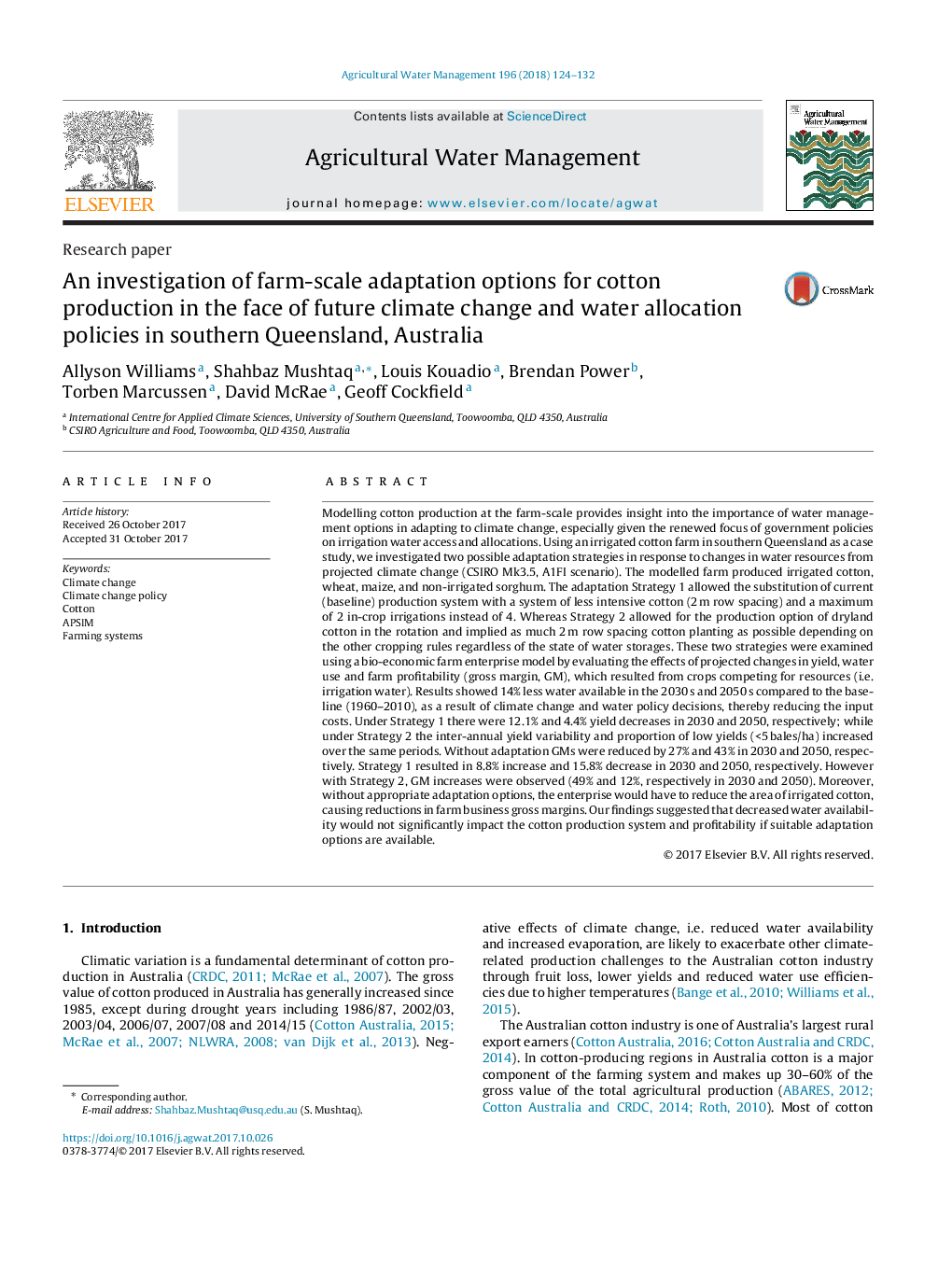| کد مقاله | کد نشریه | سال انتشار | مقاله انگلیسی | نسخه تمام متن |
|---|---|---|---|---|
| 8873195 | 1622884 | 2018 | 9 صفحه PDF | دانلود رایگان |
عنوان انگلیسی مقاله ISI
An investigation of farm-scale adaptation options for cotton production in the face of future climate change and water allocation policies in southern Queensland, Australia
ترجمه فارسی عنوان
تحقیق در مورد گزینه های سازگاری در سطح مزرعه برای تولید پنبه در مقابله با تغییرات آب و هوایی آینده و سیاست های تخصیص آب در جنوب کوئینزلند
دانلود مقاله + سفارش ترجمه
دانلود مقاله ISI انگلیسی
رایگان برای ایرانیان
کلمات کلیدی
موضوعات مرتبط
علوم زیستی و بیوفناوری
علوم کشاورزی و بیولوژیک
علوم زراعت و اصلاح نباتات
چکیده انگلیسی
Modelling cotton production at the farm-scale provides insight into the importance of water management options in adapting to climate change, especially given the renewed focus of government policies on irrigation water access and allocations. Using an irrigated cotton farm in southern Queensland as a case study, we investigated two possible adaptation strategies in response to changes in water resources from projected climate change (CSIRO Mk3.5, A1FI scenario). The modelled farm produced irrigated cotton, wheat, maize, and non-irrigated sorghum. The adaptation Strategy 1 allowed the substitution of current (baseline) production system with a system of less intensive cotton (2Â m row spacing) and a maximum of 2 in-crop irrigations instead of 4. Whereas Strategy 2 allowed for the production option of dryland cotton in the rotation and implied as much 2Â m row spacing cotton planting as possible depending on the other cropping rules regardless of the state of water storages. These two strategies were examined using a bio-economic farm enterprise model by evaluating the effects of projected changes in yield, water use and farm profitability (gross margin, GM), which resulted from crops competing for resources (i.e. irrigation water). Results showed 14% less water available in the 2030Â s and 2050Â s compared to the baseline (1960-2010), as a result of climate change and water policy decisions, thereby reducing the input costs. Under Strategy 1 there were 12.1% and 4.4% yield decreases in 2030 and 2050, respectively; while under Strategy 2 the inter-annual yield variability and proportion of low yields (<5Â bales/ha) increased over the same periods. Without adaptation GMs were reduced by 27% and 43% in 2030 and 2050, respectively. Strategy 1 resulted in 8.8% increase and 15.8% decrease in 2030 and 2050, respectively. However with Strategy 2, GM increases were observed (49% and 12%, respectively in 2030 and 2050). Moreover, without appropriate adaptation options, the enterprise would have to reduce the area of irrigated cotton, causing reductions in farm business gross margins. Our findings suggested that decreased water availability would not significantly impact the cotton production system and profitability if suitable adaptation options are available.
ناشر
Database: Elsevier - ScienceDirect (ساینس دایرکت)
Journal: Agricultural Water Management - Volume 196, 31 January 2018, Pages 124-132
Journal: Agricultural Water Management - Volume 196, 31 January 2018, Pages 124-132
نویسندگان
Allyson Williams, Shahbaz Mushtaq, Louis Kouadio, Brendan Power, Torben Marcussen, David McRae, Geoff Cockfield,
